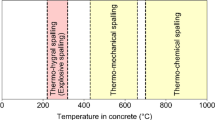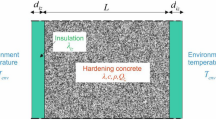Abstract
This paper presents long term creep data from high performance concretes (HPC) sourced from different research programs or civil engineering projects carried out at IFSTTAR’s Paris laboratory, France. The authors are now making all this data publicly available through a data archive. The experimental procedures are described in detail, in particular that used to verify the constancy over time of the specimens’ compressive stress. It is shown that the majority of the concretes exhibit linear long-term behavior when plotted against log (time). Indeed, the paper describes modelling sourced from the literature, based on a logarithmic function of time which, despite its simplicity, matches the experimental data quite well. Using this modelling, we studied the behavior of HPC prepared from the same set of constituents. We have shown that the logarithmic change in creep is a quasi linear function of the water to cement ratio and aggregate concentration. Finally, the accuracy of the fib MC2010 model code has been tested on IFSTARR’s data bank.










Similar content being viewed by others
References
Bazant ZP, Qiang Y, Guang-Hua L (2012) Excessive long-time deflections of prestressed box girders: I. Record-span bridge in Palau and other paradigms. ASCE J Struct Eng 138(6):676–686
Sellin JP, Barthelemy JB, Torrenti JM, Bondonnet G (2014) Delayed deformations of segmental prestressed concrete bridges: the case of the Savines Bridge. AMS conference, Delft
Torrenti JM, Le Roy R (2015) Analysing and modelling basic creep. In Concreep-10 conference, Vienna
Vandamme M, Ulm F (2013) Nanoindentation investigation of creep properties of calcium silicate hydrates. Cem Concr Res 52:38–52
Brooks JJ (2005) 30-Year creep and shrinkage of concrete. Mag Concr Res 57(9):545–556
RILEM TC-242-MDC (2015) Multi-decade creep and shrinkage of concrete: material model and structural analysis, Model B4 for creep, drying shrinkage and autogenous shrinkage of normal and high-strength concretes with multi-decade applicability. Mater Struct 48(4):753–770
Sellier A, Multon S, Buffo-Lacarrière L, Vidal T, Bourbon X, Camps G (2016) Concrete creep modelling for structural applications: non-linearity, multi-axiality, hydration, temperature and drying effects. Cem Concr Res 79:301–315
Hubler MH, Wendner R, Bažant ZP (2015) Comprehensive database for concrete creep and shrinkage: Analysis and recommendations for testing and recording. ACI Mater J 112(4):547–558
http://www.civil.northwestern.edu/people/bazant/CreepShrinkData_131127.xlsx
Hanson JA (1953) A 10-year study of creep properties of concrete. Concrete Lab. Rep. Sp-38, Division of Engineering Laboratories, US Dept. of the interior, Bureau of Reclamation, Denver
Browne R, Blundell R (1969) The influence of loading age and temperature on the long term creep behaviour of concrete in a sealed, moisture stable state. Mater Struct 2:133–143
Troxell GE, Raphael JE, Davis RW (1958) Long time creep and shrinkage tests of plain and reinforced concrete. Proc ASTM 58:1101–1120
Benboudjema F, Torrenti JM (2015) On the very long term delayed behaviour of biaxially prestressed structures: the case of the containments of nuclear power plants, Concreep10 conference, Vienna
Barthélémy JF, Sellin JF, Torrenti JM (2015) The effects of long term behavior of both concrete and prestressing tendons on the delayed deflection of a prestressed structure. Concreep10 conference, Vienna
Wendner R, Hubler MH, Bažant ZP (2015) Optimization method, choice of form and uncertainty quantification of Model B4 using laboratory and multi-decade bridge databases. Mater Struct 48(4):771–796
Le Roy R (1995) déformations instantanées et différées des bétons de hautes performances. thèse de l’école nationale des ponts et chaussées, spécialité matériaux et structures. Instanteneous and delayed deformations of high performance concrete, PhD thesis, école nationale des ponts et chaussées, Paris, In French
Acker P, Bazant ZP, Chern JC, Huet C, Wittmann FH (1998) Measurement of time-dependent strains of concrete. RILEM TC 107-CSP, Creep and shrinkage prediction models: principles of their formulation. Mater Struct 31:507–512
Toutlemonde F, Le Maou F (1996) Protection des éprouvettes de béton vis-à-vis de la dessiccation-Le point sur quelques techniques de laboratoires. The protection of concrete samples from dessication-some laboratory techniques. Bulletin des Ponts et Chaussées 203:105–119 in French
Toutlemonde F, Boulay C, Rossi P (1995) High strain rate tensile behavior of concrete: significant parameters. In: Fracture Mechanics of Concrete Structures, Proceedings FRAMCOS-2. AEDIFICATIO publishers, Freiburg, pp 709–718
Le Roy R, Cussac JM, Martin O (1999) Structures sensitive to creep: from laboratory experimentation to structural design: The case of the Avignon high-speed rail viaduct, Creep and shrinkage of concrete. Rev Fran Gén Civ Hermes Sci Pub 3(3):133
Auperin M, De Larrard F, Richard P, Acker P (1989) Retrait et fluage de bétons à hautes performances aux fumées de silice-Influence de l’âge au chargement, shrinkage and creep of high performance concretes, influence of the loading age. Ann. de l’ITBTP, Série béton, in French 254, 474
Cadoret G, Richard P (1992) Full scale use of high performance concrete in building and public works. In “High performance concrete”, edited by Y. Malier, E&FN Spon
Le Roy R, Boulay C Le Maou F (1999) étude du retrait et du fluage du béton M100 et M120, Rapport pour le plan Génie Civil, projet national BHP 2000, Paris. Creep and shrinkage study of HPC M100 et M120. Report fort the Civil engineering plan, National French Project, BHP 2000, in French
Virlogeux M, Servant C, Cremer JM, Martin JP, Buonomo M (2005) Millau viaduct. Struct Eng Intern 1:4–7
Le Roy R (1996) pré étude de formulation des bétons de hautes performances B80, essais de retrait et fluage sur les 2 BHP. Report for agence interdépartementale des ouvrages d’art (AIOA), ministère de l’aménagement, de l’équipement et des transports. Mix design pre study of concrete B80, creep and shrinkage tests on the 2 HPC, Report for the French ministry of country planning, equipment and transport, in French
Müller H, Anders I, Breiner R, Vogel M (2013) Concrete: treatment of types and properties in fib Model Code 2010. Struct Concr 14(4):320
Acker P, Ulm F (2001) Creep and shrinkage of concrete: physical origins and practical measurements. Nucl Eng Des 203:143–158
Zhang Q, Le Roy R, Vandamme M, Zuber B (2014) Long term creep properties of cementitious material: comparing microindentation testing with macroscopic uniaxial compressive testing. Cem Concr Res 58:89–98
Author information
Authors and Affiliations
Corresponding author
Ethics declarations
Conflict of interest
The authors declare that they have no conflict of interest.
Funding
Part of this study was funded by the Agence Inter-départementale des Ouvrages d’Art (AIOA) for the Millau Viaduct project (experiments on concretes Millau B80 and Millau B80FS), and by the IREX institute (experiments on concretes M100B, M12B, and M120C). The rest (Le Roy’s thesis) was funded by the French Ministry of Equipment (which has since become the Ministry of Ecology).
Rights and permissions
About this article
Cite this article
Le Roy, R., Le Maou, F. & Torrenti, J.M. Long term basic creep behavior of high performance concrete: data and modelling. Mater Struct 50, 85 (2017). https://doi.org/10.1617/s11527-016-0948-8
Received:
Accepted:
Published:
DOI: https://doi.org/10.1617/s11527-016-0948-8




